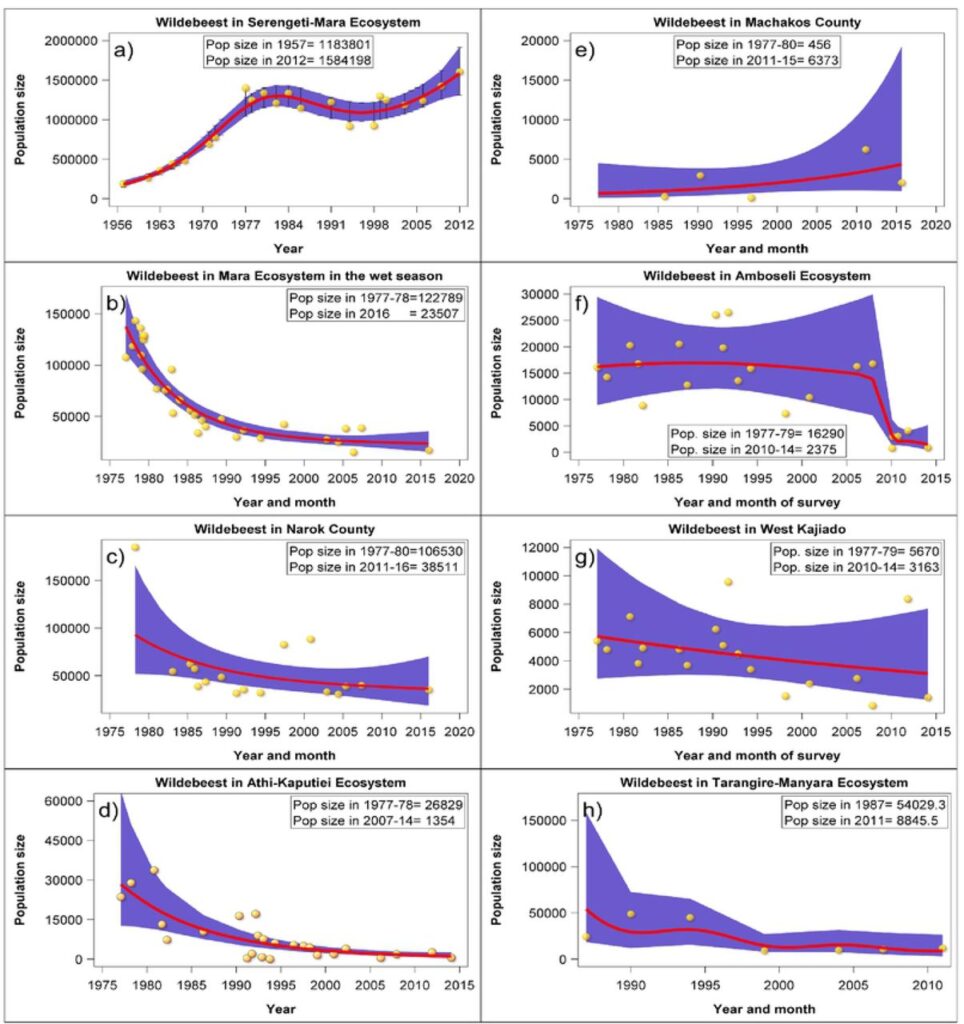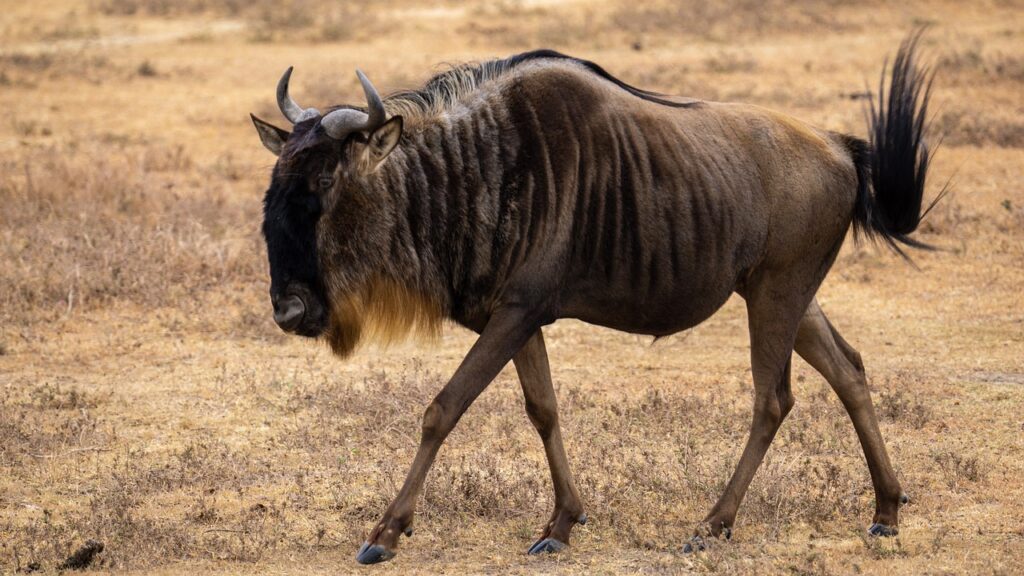The 2019 study titled ‘Wildebeest migration in East Africa: Status, threats and conservation measures’ and led by Fortunata U. Msoffe, Joseph O. Ogutu, and other researchers, offers a comprehensive evaluation of the status, threats, and potential conservation strategies for wildebeest populations in East Africa. The research highlights the urgent need for effective conservation measures to preserve the remaining migratory routes in the face of escalating human encroachment and environmental challenges. Below are the key findings and statistics:
1. Status of Wildebeest Migrations:
- Dramatic Population Declines: The study recorded alarming reductions in four out of the five primary migratory wildebeest populations in East Africa, including the Serengeti-Mara, Athi-Kaputiei, Mara-Loita, Tarangire-Manyara, and Greater Amboseli ecosystems.
- Serengeti-Mara Migration: This is the largest remaining wildebeest migration route, spanning approximately 40,000 km² between Kenya and Tanzania. Despite sustaining an estimated 1.3 million individuals since 1977, the number of wildebeests crossing from the Serengeti to the Maasai Mara declined by 73% from 588,000 in 1979 to 157,000 in 2016.
- Mara-Loita Migration: The population here plummeted by 81%, from over 123,000 wildebeests in 1977 to under 20,000 in 2016, posing a critical risk to the survival of the ecosystem.
- Athi-Kaputiei Migration: Located near Nairobi, Kenya, this migration faced the most significant decline of 95%, from 27,000 in 1977 to fewer than 3,000 animals by 2014.
- Greater Amboseli Migration: Spanning about 7,730 km², this ecosystem saw an 85% decline in its migratory wildebeest population, from 16,300 in 1977 to under 2,400 in 2014.
- Tarangire-Manyara Migration: This ecosystem, located in northern Tanzania and covering 35,000 km², experienced a 72% decline in migrating wildebeest from 48,800 in 1990 to 13,600 in 2016.
Here is the data in a simplified table format;
| Migration Route | Region | Area (km²) | Population Decline | Population Change (1970s/1990s to recent) |
|---|---|---|---|---|
| Serengeti-Mara Migration | Spans Kenya and Tanzania | 40,000 | 73% decline | From 588,000 in 1979 to 157,000 in 2016 |
| Mara-Loita Migration | South-western Kenya | 7,500 | 81% decline | From 123,000 in 1977 to under 20,000 in 2016 |
| Athi-Kaputiei Migration | Near Nairobi, Kenya | 2,200 | 95% decline | From 27,000 in 1977 to fewer than 3,000 in 2014 |
| Greater Amboseli Migration | Straddles Kenya and Tanzania | 7,730 | 85% decline | From 16,300 in 1977 to under 2,400 in 2014 |
| Tarangire-Manyara Migration | Northern Tanzania | 35,000 | 72% decline | From 48,800 in 1990 to 13,600 in 2016 |

Ecosystems Studied
The map shows the general extent of Masailand in Kenya and Tanzania, depicting various wildebeest ecosystems studied in Ogutu’s research, each with distinct ecological dynamics and populations. Let’s break down the major ecosystems and their corresponding populations and reserves based on Ogutu’s findings:
1. Serengeti Ecosystem (1)
- Location: Mainly in Tanzania, this is one of the most well-known ecosystems in the world, encompassing the Serengeti National Park (SNP), Maswa Game Reserve (MGR), and adjacent reserves like Grumeti (GGR) and Ikorongo (IGR).
- Seasonal Usage: Wildebeest migrate seasonally through these areas, with the wet season (shown in green) providing abundant grazing lands. During the dry season, they retreat to areas marked in yellow.
- Population: This is home to the largest population of migratory wildebeests, estimated at over 1.3 million. However, migration numbers to the Maasai Mara have reduced significantly, threatening long-term population stability.
2. Masai Mara Ecosystem (2)
- Location: In Kenya, primarily within the Masai Mara National Reserve (MMNR), this ecosystem is a critical extension of the Serengeti migration route.
- Seasonal Usage: Dry season grazing (yellow) is significant in the Masai Mara, with the wildebeest depending heavily on these areas after migrating from the Serengeti.
- Population: The migration into the Maasai Mara from the Serengeti has declined by 73%, with only 157,000 wildebeest crossing the border by 2016.
3. Narok County (3)
- Location: This area in Kenya covers regions to the north of the Maasai Mara, encompassing agricultural and pastoralist landscapes.
- Threats: Intensive land use changes, agriculture, and expanding human settlements disrupt migration routes and reduce available habitats for wildebeest herds.
4. Athi-Kaputiei Ecosystem (4)
- Location: Located near Nairobi, Kenya, it includes Nairobi National Park (NNP). This ecosystem is heavily affected by urbanization and infrastructure development.
- Population: The wildebeest population here has seen a 95% decline, with numbers dropping from 27,000 in 1977 to fewer than 3,000 in recent years.
- Threats: Encroachment from Nairobi’s expanding suburbs, roads, fences, and livestock grazing pose significant threats to migratory routes.
5. Machakos County (5)
- Location: Southeast of Nairobi, this region is characterized by increasing urban and agricultural development.
- Population: The region is primarily impacted by agricultural expansion, and its relevance to wildebeest populations is connected to the movement of herds from surrounding ecosystems.
6. Greater Amboseli Ecosystem (6)
- Location: Straddling the Kenya-Tanzania border, it includes Amboseli National Park (ANP) and surrounding private conservancies.
- Population: This area saw an 85% decline in wildebeest, from 16,300 in 1977 to under 2,400 in 2014.
- Seasonal Usage: The dry season area (yellow) within Amboseli National Park is critical for the survival of wildebeest during periods of drought.
- Threats: Human-wildlife conflict, overgrazing by livestock, and lack of coordinated conservation efforts severely impact this ecosystem.
7. West Kajiado (7)
- Location: Situated west of Amboseli, this region is heavily influenced by pastoralist activities and is not protected by any national parks.
- Population: Though not a primary wildebeest migratory route, human settlement and livestock grazing influence wildlife corridors connecting Amboseli and other ecosystems.
8. Tarangire-Manyara Ecosystem (8)
- Location: In northern Tanzania, it encompasses Tarangire National Park (TNP), Lokisale Game Controlled Area (LGCA), and the Mkungunero Game Reserve (MGR).
- Population: This ecosystem has experienced a 72% decline in migratory wildebeest from 48,800 in 1990 to 13,600 in 2016.
- Seasonal Usage: Wet season grazing (green) is abundant, but during the dry season, wildebeest depend on critical areas within Tarangire National Park and surrounding reserves (yellow areas).
- Threats: Increasing agricultural activities, fencing, and poaching, combined with a lack of sustainable conservation strategies, contribute to the decline of this migration.
Summary of Threats and Conservation Challenges:
- Fences, Settlements, and Roads: Human-made barriers have restricted traditional migration routes, resulting in genetic isolation and habitat fragmentation.
- Agricultural Expansion: As shown in regions like Narok and Athi-Kaputiei, growing agricultural activities have diminished grazing lands and increased human-wildlife conflict.
- Overgrazing by Livestock: Competing with wildebeest for food and water resources, livestock are an increasing pressure, particularly in Amboseli and West Kajiado.
- Declining Populations: Across most ecosystems, wildebeest populations have plummeted by 70-90%, with the largest declines seen in Athi-Kaputiei and Mara-Loita.
- Conservation Measures: To mitigate these threats, robust law enforcement, habitat restoration, wildlife corridors, and partnerships with local communities are essential to preserve these migratory populations.
This expert breakdown provides a detailed understanding of the key ecosystems, their significance to wildebeest populations, and the threats they face, as mapped out in Ogutu’s study.
2. Threats to Wildebeest Migrations:
- Human Infrastructure: Expanding roads, fences, settlements, and agricultural projects have fragmented and obstructed migratory corridors. This fragmentation prevents the wildebeests from accessing essential resources like water, grazing areas, and calving grounds.
- Poaching and Illegal Hunting: Increased poaching for bushmeat in areas with declining wildlife protection has further exacerbated the threat to these populations.
- Overgrazing and Competition with Livestock: Livestock overgrazing in areas previously used by wildebeest has led to a reduction in food availability, leading to malnutrition and population stress.
- Policy Failures: Conservation policies in Kenya and Tanzania have failed to adequately protect wildlife on private and community lands, where approximately 65% of the threatened wildebeest populations reside. Government wildlife management has largely focused on protected areas, which cover only 8% of Kenya’s land and house 35% of its wildlife.
3. Genetic Impact of Population Declines:
- The study highlights that wildebeest populations suffering from habitat fragmentation and reduced migratory freedom are more genetically vulnerable. Non-migratory wildebeests are subject to higher rates of inbreeding, which reduces genetic diversity and weakens their resilience to environmental changes, diseases, and droughts.
4. Conservation Measures and Recommendations:
- Protection of Migration Corridors: The study stresses the importance of safeguarding existing migration routes through better land-use planning, regulation, and infrastructure modifications (such as underpasses or overpasses for wildlife).
- Community Involvement: The involvement of local communities is crucial to ensuring the sustainable management of land and wildlife. Wildlife conservancies have proven to be effective models, where landowners are paid to maintain wildlife-friendly areas. However, more support is needed to expand and manage these conservancies.
- Land Acquisition for Conservation: Buying land for conservation or securing long-term leases from local communities is recommended to ensure that critical migration routes are protected from agricultural expansion.
- Cross-border Cooperation: Since wildebeest migrations cross national borders, cooperation between Kenya and Tanzania is essential for trans-boundary wildlife management and migration conservation efforts.
- Drought Management: Given the increased frequency of droughts, additional efforts are needed to manage water resources, protect critical rivers (e.g., the Mara River), and implement drought mitigation strategies to ensure wildebeest survival during dry seasons.
5. Consequences of Inaction:
- If immediate and sustained conservation efforts are not implemented, the study warns that East Africa’s wildebeest migrations could face local extinction in several ecosystems. Other migratory species, such as zebras and Thomson’s gazelles, have already seen major population declines, with some migrations in Kenya’s Rift Valley and other regions already lost.
This study is pivotal in highlighting the urgent need for comprehensive conservation measures to prevent the extinction of one of Africa’s most iconic wildlife spectacles. If not addressed, the collapse of wildebeest migrations will have profound ecological consequences on biodiversity and the ecosystems that rely on these migratory patterns.

